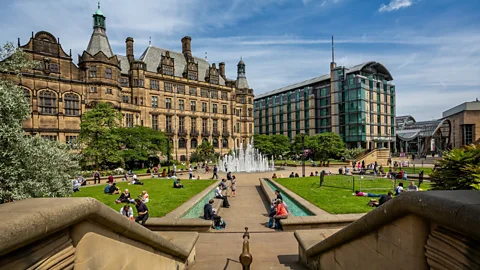ADS
He broke records all across the globe, yet nobody would even talk to him at home. The United States’ highest civilian accolade might soon go to the best athlete you’ve never heard of.
Worcester, Massachusetts is home to a small museum that has a black-and-white picture from 1901. The image depicts a guy stooped over his racing bicycle, his gaze fixed on the camera. You can feel the intensity of his stare as his fingers tighten over the drop bars and his biceps bulge within his wool sweater.
Even though he was the first African American to become a worldwide sports sensation, Marshall “Major” Taylor was more than simply a world champion in cycling—a sport that was immensely popular in his day.
Rediscovering America is a travel series on BBC Two that turns the tables on well-known American history, culture, and communities by sharing the uplifting tales of these lesser-known but no less significant parts of the United States.
During the height of Jim Crow in the US, Taylor had an improbable climb to fame. His father was a Civil War soldier, and he spent his childhood in Indianapolis, Indiana, after being born in 1878. He started doing stunts outside of a neighborhood bike store to entice clients when he was a kid after receiving a bicycle as a present. He went to the YMCA to hone his riding abilities, but the staff there would not work with him due to his race. Fearless, he began participating in every event that would admit African Americans and shown an early aptitude for high-intensity, short sprints.
Retired penny farthing bike racer and entrepreneur Louis “Birdie” Munger took an immediate interest in Taylor. Munger clocked Taylor’s one-mile sprint at 2 minutes and 9 seconds, which was only two seconds slower than the 1893 world record. Munger took on the role of coach, mentor, and sponsor for Taylor. Munger built a new bicycle factory in Worcester, Massachusetts, in 1895, and he invited a young Taylor to reside there. This more progressive neighborhood enabled Taylor to join the YMCA, unlike in Indianapolis, and that’s where he started training seriously.
The Major Taylor Association, a nonprofit that celebrates Taylor’s life and work, was headed by Lynne Tolman. “Major Taylor lived in Worcester most of his life, from 1895 to 1930,” she stated. He was referred to as ‘the Worcester Whirlwind’ by the media. Undoubtedly, there were challenges, such as the white neighbors’ disapproval when Taylor purchased a home in Worcester. Worcester is rightfully proud of its native son’s meteoric rise to worldwide sports stardom, but in the end, Taylor found a comfortable home in the city.
In his 2019 book The World’s Fastest Man, writer Michael Kranish recounts how, during his time, track star Jim Taylor won many races and broke world records. Taylor was a staunch Christian who refused to compete on Sundays and shunned booze and tobacco in order to project an image of integrity. His numbers are still mind-blowing when compared to the standards of current racing. For instance, in 1898, he ran a mile in 57.6 seconds; contemporary record holder Jeffrey Hoogland of the Netherlands holds the record at 55.433 seconds.
Nonetheless, Taylor encountered incessant animosity in his own nation. The current-day League of American Bicyclists has its origins in the 1885 effort to outlaw Black people by the United States League of American Wheelmen. Caricatures of Taylor were published in newspapers in a ridiculing tone, and when he was finally permitted to participate, the name of the contest would be proclaimed by brass bands while the song “Dixie” was played. This song had its origins in racist minstrel shows in the 1850s and later became the unofficial hymn of the USA Civil War. On the track, Taylor’s opponents often utilized nasty tactics, such as trying to trap him in a group or dangerously upend his bike, while advertisements portrayed his races as a conflict between Black and white sportsmen. A white racer in Taunton, Massachusetts, once suffocated Taylor into unconsciousness by removing him from his bike.
All around the United States, restaurants and hotels turned their backs on Taylor as racial segregation from the Jim Crow period became more extreme at the start of the twentieth century. The athlete was then asked to compete in races in Canada, Europe, and Australia by promoters, who were met with enthusiastic press and sold-out crowds. Thanks in large part to Taylor, the “safety bicycle”—a considerably safer option than the old penny farthings—became widely used. But sports reporters followed his every move, and his health and marriage suffered as a result of his hectic racing schedule.
One cycling path in Chicago is one of many in the United States named after Taylor. On the other hand, you may find a smaller mural of Taylor in Richmond, Virginia, and a larger one in downtown Indianapolis, both of which span five stories. However, Worcester’s steep George Street was where Taylor honed his sprinting abilities; in his honor, the city hosts the George Street Bike Challenge annually.
When he retired in 1910, Taylor joined the ranks of other forgotten sportsmen. Despite her dedication to writing, Taylor was unable to find a publisher for her 600-page book and ended up losing money when she decided to self-publish it. A number of his endeavors, including earning an engineering degree and reinventing himself as a car salesperson, eventually fizzled out. Taylor relocated to Chicago when the Great Depression began and passed away in 1932, destitute and unremembered. His age was a mere 52 years.
Before Andrew Ritchie’s 1988 book Major Taylor: The Extraordinary Career of a Champion Bicycle Rider piqued interest in the sport, his tale was a forgotten footnote. When Taylor was elected to the United States Bicycling Hall of Fame in 1989, the book was a major factor. For the purpose of “recognizing sportsmanship, promoting nonviolence, and caring for those less fortunate,” it also served as an inspiration for Worcester’s founding of The Major Taylor Association. right down the street from the one-room museum devoted to Taylor, the Worcester Public Library sits right in front of the monument that the Association constructed of him in 2008.
“Since the statue effort began, Major Taylor cycling clubs have sprouted across the country, with a few overseas,” Tolman added. A large number of bike clubs—over 80 to be exact—have contributed financially to the Major Taylor Association. To spread awareness of the champion’s life and work, the clubs serve as representatives of the organization.
But there may be even greater accolades on the way. Taylor would be bestowed the highest civilian honor bestowed upon a US citizen by the United States Congress, the Congressional Gold Medal, which is now being considered by the US House of Representatives. It would make Taylor just the 17th African American to ever earn the honor if he were to win it.
“Marshall ‘Major’ Taylor was, without a doubt, a pioneer, a brilliant athlete, and a pioneer in the world of cycling. According to Representative Jonathan L. Jackson, who is the godson of Martin Luther King, Jr. and the son of Civil Rights leader Jesse Jackson, the ‘world’s fastest man’ should be bestowed one of America’s most distinguished accolades. Representative Jackson, along with thirty-two other lawmakers, introduced the bipartisan measure in December.
A documentary filmmaker from Worcester named Cyrille Vincent observed, “[Taylor] was a man of great character and sportsmanship.” That, I think, is why, even after more than a century has passed, people speak about him. It helps to be a top-notch athlete, but what really set him apart was his composure in the face of extreme injustice and hardship.
A very personal project for Vincent, Whirlwind is a feature documentary he is directing on Taylor’s life. Vincent moved to Worcester from the Central African Republic in 2016. He had driven hundreds of times down Major Taylor Boulevard, which was close to his home. But discovering its namesake’s backstory captivated him to the point that he became fixated on the historical person and even started cycling as a hobby.
The Major Taylor Museum, housed in Worcester’s historic courthouse, debuted in October 2021, only steps away from the road that bears his name. The one-room display is beautifully put together, with blown-up archive photos lined up along the brick walls, a vintage racing bike preserved under glass, and a French magazine from the time documenting one of his European journeys among the artifacts on display. Visitors may engage with history via the use of touch-screens, a pair of stationary bicycles, and explanatory plaques placed around the museum.
“Our visitors run the gamut,” said Sharon Freed, manager of the museum. We encounter a lot of bikers since cyclists are the ones that know Major’s tale best. From parents with little children to elementary and college students, university staff and professors, non-profit executives, local and state officials, tourists, and many more, we encounter professionals who once worked in the building, when it was the city’s courtroom.
“To the best of our knowledge, there is no other place like this,” according to her.
The perfect eulogy for an extraordinary guy whose life story is unlike any other.






